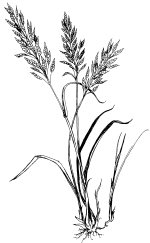
2008-present: Koester Site
In 2008, Craig Koester, grandson of landowner Walter Koester, decided to begin the process of conserving his land.
The site contains concentrated areas of two vanishing North American habitats, Native Prairie and Dry Hill Oak Savanna, deeming it eligible for the Native Prairie Bank Easement Program. There is currently a Native Prairie Bank Easement on 133 acres of the site.
The Trust for Public Land facilitated a transition of the site from the Koester Family's ownership to State ownership in 2014, and today the site is designated as a wildlife management area. The site is open to the public for activities such as hiking, hunting and birdwatching.

The Koester family with a map showing Koester Prairie at the 2014 dedication.
Motivation for Conservation
Ever since Walter Koester purchased the land in the late 1930s, the Koester family forged a deep familial and personal connection with the land. Prairie Creek has been the site of many profound, meaningful childhood experiences for Craig Koester, which has inspired him to think of land conservation as a core value, rather than just a way to transfer control of his land.
It was important to the Koester family that the land would remain in a natural state that would foster wildlife and provide open conservation spaces. Although it is common for grassland to be sold for development and divided into housing units, the Koesters wanted to find a way to work with the value of conservation.
Phase One: The Native Prairie Bank
In 2009, the Department of Natural Resources (DNR) conducted surveys on Prairie Creek's biotic and abiotic features. From their findings, the northern portion of grassland contained a high concentration of native species, thus the site was eligible to be incorporated into the Native Prairie Bank, which is a record of Minnesota’s areas of native prairie conserved under easement.
In 2011, the Koesters sold a Native Prairie Bank Conservation Easement to the DNR. The map below shows the 133 acres of easement land outlined in red, in the context of the entire site, which is outlined in blue.
The easement's specific regulations on landowners' activities can be seen on the "Baseline Property Report" for the site, which is available in the Carleton College Digital Collections, Prairie Creek Wildlife Management Area Digital Collection.

This map shows the 133 acres of easement land outlined in red, in the context of the entire site, which is outlined in blue.

Going Further: The Trust for Public Land
After selling the Native Prairie Bank Easement to the DNR, Dr. Koester still wanted to conserve the 327 remaining acres of his land that were not eligible for the easement program.
After a DNR representative contacted the Trust for Public Land (TPL), the TPL began investigating the site in 2012, using methods of surveying, environmental assessment and title investigation.
After their investigative research, the TPL purchased the 327 non-easement acres, using both private funds and funds from the Outdoor Heritage Fund, created by the Legacy Amendment to the Minnesota Constitution.
Phase Two: The Wildlife Management Area
The second phase of the conservation of Prairie Creek was the designation of the entire property as a Wildlife Management Area.

This map shows different types of land cover at the site, a sign of the significant biodiversity of the property. (Created by Carleton College ENTS 110 students, 2015)
Prairie Creek WMA
In early 2014, the Trust for Public Land then sold the entire 460-acre property to the Department of Natural Resources (DNR), who then proceeded to open the site to the public in June.
Prairie Creek was designated as a WMA due to its habitat quality and diversity, potential for habitat improvement, and location in ecologically diverse and valuable area. The map above shows different types of land cover at the site, a sign of the significant biodiversity of the property.
Wildlife Management Area
According to the DNR, a Wildlife Management Areas are “lands and waters that have a high potential for wildlife production, public hunting, trapping, fishing, and other compatible recreational uses.”
WMAs are devoted to the conservation of wildlife species through habitat restoration as well as wildlife focused recreation, such as birding and hunting.
How do WMAs differ from state parks?
In Minnesota, state parks are created with recreation as the primary consideration, and include greater facilities for active recreation, such as campgrounds. WMAs differ because conservation is prioritized over recreation.
A Collective Management Effort


Now that the land has been legally protected for conservation, it will require thoughtful management for years to come. The site is managed through a collaboration between public and private, as well as national and local actors.
The DNR, who owns the property, monitors the land, proposes stewardship practices, provides some funding through grants, and approves and overseas management practices.
The Friends of Prairie Creek is a local organization of volunteers, led by Craig Koester and David Kuhnau. They work closely with the Department of Natural Resources and the Cannon River Watershed Partnership to coordinate volunteer efforts that carry out most of the physical management activities, as well as seek additional funding sources.
Management activities that have been practiced for several years and continue today include removal of invasive species such as buckthorn, wild parsnip and Queen Anne's lace, as well as prescribed burning. These activities are an important part of maintaining the ecological well-being and the valuable biodiversity of the site.
Explore the prairie history by navigating the different periods of the site using the table of contents below.


